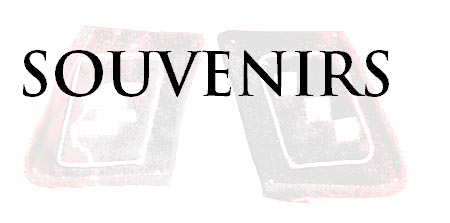
MARK BANDO'S WEBSITE
Closing-In, May 1945 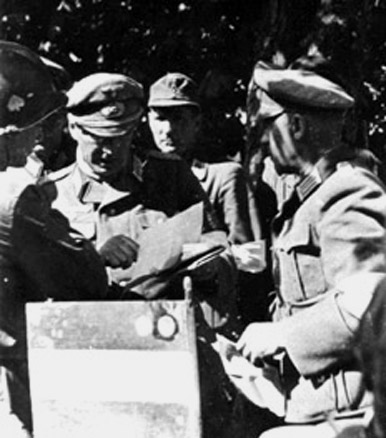 Somewhere in Bavaria, Spring, 1945. An officer of 1st Bn.,506th PIR talks with Germany Army officers, to arrange surrender of their troops. Note the white arm brassard on the officer at right. Photo c/o Don Brinninstool
Somewhere in Bavaria, Spring, 1945. An officer of 1st Bn.,506th PIR talks with Germany Army officers, to arrange surrender of their troops. Note the white arm brassard on the officer at right. Photo c/o Don Brinninstool
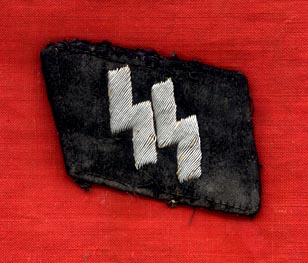 While riding on DUKWs east from Munich on the Autobahn in late April, 1945, a convoy carrying 1/506th troops paused for a rest break. Other troops had rounded-up some prisoners, who were standing at the side of the highway. Amongst them was a haughty-looking SS Sgt, wearing the double runic lightning flash collar patch shown above. Judging from the amount of wear and dirt on the tab, the sgt was probably a veteran/survivor of many battles.
While riding on DUKWs east from Munich on the Autobahn in late April, 1945, a convoy carrying 1/506th troops paused for a rest break. Other troops had rounded-up some prisoners, who were standing at the side of the highway. Amongst them was a haughty-looking SS Sgt, wearing the double runic lightning flash collar patch shown above. Judging from the amount of wear and dirt on the tab, the sgt was probably a veteran/survivor of many battles.
Robert Wiatt of C/506th wanted to find out just how tough the SS Sgt really was. He walked over, drew his M-3 trench knife from his ankle and held it to the German's throat. As he did that, his buddy Ken Parker ran around behind the German and grasped his arms. The SS trooper maintained his calm and remained standing at attention, staring straight ahead. Wiatt used his knife to remove the collar patch for a souvenir, then the troopers remounted their vehicles and continued on-destination Berchtesgaden.
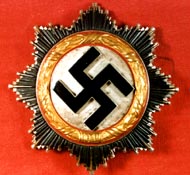
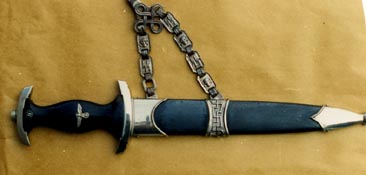 The War Order of the German Cross in Gold was instituted in 1941. It was the 2d highest decoration in the German Armed Forces for bravery in combat. The specimen at above left was plucked from the right chest of a fallen German by Jack Sauls, HQ/1 506th, in April, 1945. The 506th was enroute to Berchtesgaden in DUKWs when some Germans offered resistance in a patch of woods. After the battle, Sauls liberated this decoration which bears a manufacturer's code of '20' on the reverse. The M36 SS chained dagger with anodized scabbard was given to Sgt Bill Knight of SV/506th as a souvenir by a surrendering SS officer near Bad Gastein, Austria in May, 1945.
The War Order of the German Cross in Gold was instituted in 1941. It was the 2d highest decoration in the German Armed Forces for bravery in combat. The specimen at above left was plucked from the right chest of a fallen German by Jack Sauls, HQ/1 506th, in April, 1945. The 506th was enroute to Berchtesgaden in DUKWs when some Germans offered resistance in a patch of woods. After the battle, Sauls liberated this decoration which bears a manufacturer's code of '20' on the reverse. The M36 SS chained dagger with anodized scabbard was given to Sgt Bill Knight of SV/506th as a souvenir by a surrendering SS officer near Bad Gastein, Austria in May, 1945.
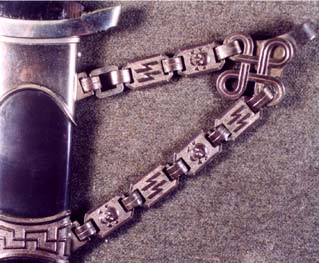 Above, a detailed shot of the linked chain, which suspends Bill Knight's 1936 model SS dagger.
Above, a detailed shot of the linked chain, which suspends Bill Knight's 1936 model SS dagger.
Waffen SS Major General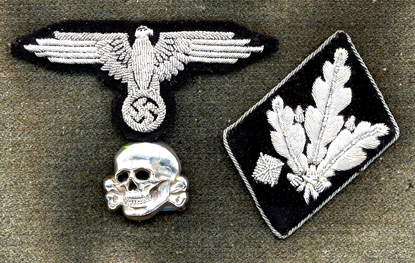 While in the Obersalzberg complex, certain members of B/506th captured a 'Gruppenfuhrer' (SS Major General), and relieved him of his pistol and various insignia and decorations. The rank collar patch-3 leaves and a pip, plus a hand-embroidered sleeve eagle with snaps on reverse, and a silver plated deathshead from the general's cap, were retained by Bob Reeves.
While in the Obersalzberg complex, certain members of B/506th captured a 'Gruppenfuhrer' (SS Major General), and relieved him of his pistol and various insignia and decorations. The rank collar patch-3 leaves and a pip, plus a hand-embroidered sleeve eagle with snaps on reverse, and a silver plated deathshead from the general's cap, were retained by Bob Reeves.
Keys to the Elevator Tunnel of the Eagles Nest
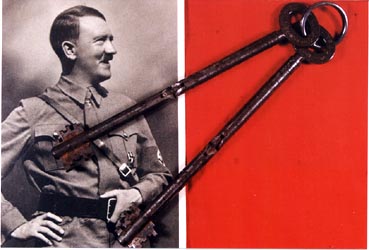 In 1945, shortly after cessation of hostilities in the E.T.O., members of the 101st Airborne occupied the Obersalzberg area including Hitler's Mountain home, the Berghof, as well as neighboring Kehlstein mountain. Atop the highest part of that mountain is a building built as a conference room for Adolf Hitler. This engineering miracle was a present from his "secretary", Martin Bormann. This building, which is still standing was nicknamed 'The Eagles Nest' by American troops and can now be visited as the 'Kehlstein Teahouse'. The keys pictured above once opened the thick armored doors of the entrance to the hallway, leading to the elevator to the Eagle's Nest. They were 'liberated' by Dick Frame of HQ/1, 501 PIR. After Frame died, his widow passed the keys along to Paul Bebout, a veteran of the same company, who donated them to the webmaster's collection. The keys are hinged to fold in the middle for pocket carrying, and are marked: 'Bode-Panzer A.G.
Hannover-Berlin'
In 1945, shortly after cessation of hostilities in the E.T.O., members of the 101st Airborne occupied the Obersalzberg area including Hitler's Mountain home, the Berghof, as well as neighboring Kehlstein mountain. Atop the highest part of that mountain is a building built as a conference room for Adolf Hitler. This engineering miracle was a present from his "secretary", Martin Bormann. This building, which is still standing was nicknamed 'The Eagles Nest' by American troops and can now be visited as the 'Kehlstein Teahouse'. The keys pictured above once opened the thick armored doors of the entrance to the hallway, leading to the elevator to the Eagle's Nest. They were 'liberated' by Dick Frame of HQ/1, 501 PIR. After Frame died, his widow passed the keys along to Paul Bebout, a veteran of the same company, who donated them to the webmaster's collection. The keys are hinged to fold in the middle for pocket carrying, and are marked: 'Bode-Panzer A.G.
Hannover-Berlin'
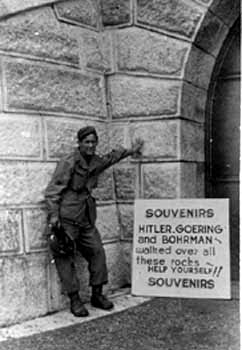 This photo was taken in June, 1945 at the entrance to the elevator tunnel which goes to the Eagles Nest. Ed Pinnix of G/502 posed next to the sign, which was a cynical commentary on the current craze for souvenir collecting. photo c/o Pinnix
This photo was taken in June, 1945 at the entrance to the elevator tunnel which goes to the Eagles Nest. Ed Pinnix of G/502 posed next to the sign, which was a cynical commentary on the current craze for souvenir collecting. photo c/o Pinnix
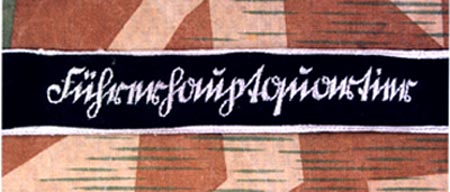 Members of the 501 PIR found a whole trunkload of these hand embroidered bullion cufftitles in the Obersalzberg area in 1945. They were worn by the German Army's escort/bodyguard detachment for Adolf Hitler, The Fuhrer Escort Brigade (Fuhrer Begleit Brigade), commanded by Fritz Rehmer. This unit was also an armored brigade, which rotated troops to and from the front lines in order to allow them the chance to be decorated. When at the front, this unit usually served with the Grossdeutschland Panzer Korps. Unlike other Army cuffbands, this one was worn on the left sleeve, like SS bands, with a Grossdeutschland band worn at
the same time on the right cuff. Like the LAH, these troops escorted Hitler in his travels and there was a detachment of them at each of his headquarters. courtesy Carl Beck H/501.
Members of the 501 PIR found a whole trunkload of these hand embroidered bullion cufftitles in the Obersalzberg area in 1945. They were worn by the German Army's escort/bodyguard detachment for Adolf Hitler, The Fuhrer Escort Brigade (Fuhrer Begleit Brigade), commanded by Fritz Rehmer. This unit was also an armored brigade, which rotated troops to and from the front lines in order to allow them the chance to be decorated. When at the front, this unit usually served with the Grossdeutschland Panzer Korps. Unlike other Army cuffbands, this one was worn on the left sleeve, like SS bands, with a Grossdeutschland band worn at
the same time on the right cuff. Like the LAH, these troops escorted Hitler in his travels and there was a detachment of them at each of his headquarters. courtesy Carl Beck H/501.
MARK BANDO'S WEBSITE
Silver Framed Hitler Portrait
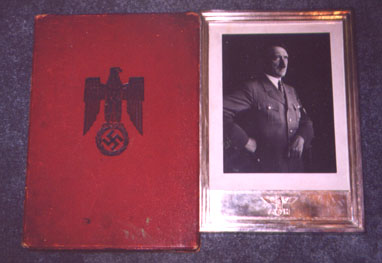 The first troopers to enter the Berghof, Hitler's mountain home at Berchtesgaden explored an underground tunnel below the house. A series of rooms connected to this tunnel, but were difficult to explore, because the electricity was no longer functioning. Using flashlights, some 506th men found a batch of hand-hammered silver framed Hitler portraits, as pictured above. These were in unissued condition and had never been written on, with the usual dedication in Hitler's handwriting. Hitler wrote on portraits, at the time he presented them as tokens of esteem, to leaders from various governments, decorated U Boat commanders, and other Third Reich war heroes.
The first troopers to enter the Berghof, Hitler's mountain home at Berchtesgaden explored an underground tunnel below the house. A series of rooms connected to this tunnel, but were difficult to explore, because the electricity was no longer functioning. Using flashlights, some 506th men found a batch of hand-hammered silver framed Hitler portraits, as pictured above. These were in unissued condition and had never been written on, with the usual dedication in Hitler's handwriting. Hitler wrote on portraits, at the time he presented them as tokens of esteem, to leaders from various governments, decorated U Boat commanders, and other Third Reich war heroes.
The example pictured above was liberated by a trooper of the 506th and I've also heard of a signed example being found elsewhere in the Obersalzberg complex, by a member of the 321st GFAB.
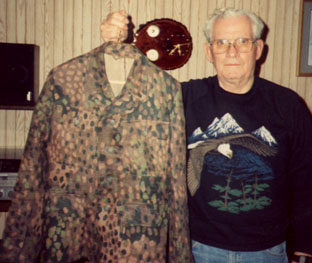 In May, 1945, Don Peterson of B/326th Airborne Engineer Bn. was at Lofer, Austria, SW of Berchtesgaden. He captured a group of Waffen SS troopers, one of whom was wearing this newly-issued, late style (HBT)SS dot pattern camouflaged tunic and earlier polished cotton dot pattern trousers.
In May, 1945, Don Peterson of B/326th Airborne Engineer Bn. was at Lofer, Austria, SW of Berchtesgaden. He captured a group of Waffen SS troopers, one of whom was wearing this newly-issued, late style (HBT)SS dot pattern camouflaged tunic and earlier polished cotton dot pattern trousers.
Don leveled his M-1 rifle at the SS man and stated:"I like that uniform-Take it off!"
The prisoner complied and Don brought the suit home to Canton, OH. Each Halloween after WW2, Don would wear the suit, while passing out candy to trick or treaters on his front porch. The suit was added to the webmaster's collection in 1991.
SS Book Plate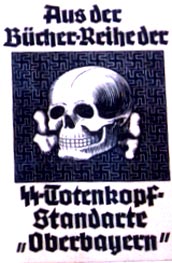 When LTC Ben Weisberg, former commander of the 377th PFA Bn. went to Dachau for 4 years of postwar occupation duty, he found this bookplate for a book from the library
of the 'Oberbayern' Regiment of the infamous 'Totenkopf' Division.
When LTC Ben Weisberg, former commander of the 377th PFA Bn. went to Dachau for 4 years of postwar occupation duty, he found this bookplate for a book from the library
of the 'Oberbayern' Regiment of the infamous 'Totenkopf' Division.
"Dem Tapferen SS" Somewhere in his travels, Wilson Boback of G/501 acquired this small piece of solid silver, engraved with wording meaning "To the Brave SS man". The small holes in the corners suggest he might have pried it off a wooden plaque? I've never seen this in any reference book on SS regalia.
Somewhere in his travels, Wilson Boback of G/501 acquired this small piece of solid silver, engraved with wording meaning "To the Brave SS man". The small holes in the corners suggest he might have pried it off a wooden plaque? I've never seen this in any reference book on SS regalia.
After requesting identification of this piece, I received an email from Todd Brickley, a collector who lives in Germany, and a US Army vet of recent vintage. Todd says he was stationed at Nuremberg and that while there, he examined a vintage SS unit flag, still mounted on a flagpole. One of the small silver plaques pictured above, was tacked vertically to the wooden flagpole. Thanks for the info, Todd.
Herman Goring Dinner Plate
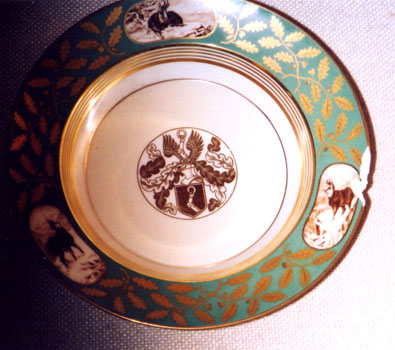 The Reichsmarschall of the German Luftwaffe had entire sets of dinner plates made in the above pattern. This slightly damaged specimen is in the effcts of General (LTC in 1945) Steve Chappuis, the last WW2 C.O. of the 502 PIR. There is slight damage to one edge of this ornate plate, which features wildlife scenes, relevant to Goring's passion for hunting big game. Note the shield at center, depicting a hand holding a battleax-this is from the Goring family coat of arms and also appears on the silver goblet depicted below.
The Reichsmarschall of the German Luftwaffe had entire sets of dinner plates made in the above pattern. This slightly damaged specimen is in the effcts of General (LTC in 1945) Steve Chappuis, the last WW2 C.O. of the 502 PIR. There is slight damage to one edge of this ornate plate, which features wildlife scenes, relevant to Goring's passion for hunting big game. Note the shield at center, depicting a hand holding a battleax-this is from the Goring family coat of arms and also appears on the silver goblet depicted below.
General Field Marshall Wilhelm Keitel
Keitel was executed by hanging after being convicted at the Nuremburg Trials, for plotting to wage an aggressive war. He had a home in the Obersalzberg complex at Berchtesgaden, which was liberated by the 101st Airborne in May, 1945.
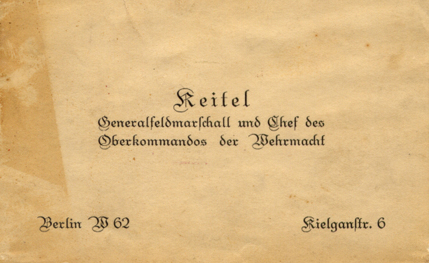 This calling card, listing Keitel's Berlin address, was taken from his Bavarian home by Lt. Charles A. Mitchell of the 506th PIR.
C.A. Mitchell had spent most of WW2 as a platoon Sgt in B/506th, but received a Battlefield Commission late in the war.
This calling card, listing Keitel's Berlin address, was taken from his Bavarian home by Lt. Charles A. Mitchell of the 506th PIR.
C.A. Mitchell had spent most of WW2 as a platoon Sgt in B/506th, but received a Battlefield Commission late in the war.
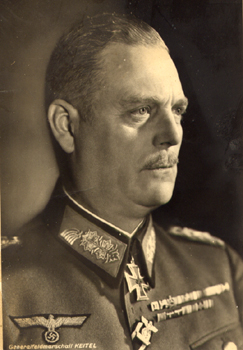 This postcard bearing a studio portrait of Keitel, was also liberated at the field marshall's home by C.A. Mitchell.
This postcard bearing a studio portrait of Keitel, was also liberated at the field marshall's home by C.A. Mitchell.
Hitler's Silverware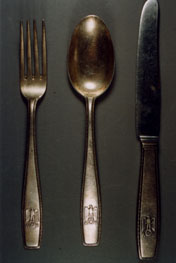
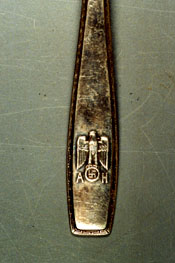 Up at the Eagle's Nest, 2 or 3 chests full of silverware marked with the Nazi national emblem and Hitler's initials, were liberated by 101st Airborne troopers. In addition, there were similarly-marked silver serving trays, tea services, salt and pepper shakers, napkin holders and many other 'A.H.' accessories. The photo above left shows a basic place setting (there are also A.H. napkins and tablecloths) and the photo above right shows the A.H. logo in detail. This style, with a Greek Key design running around the outer edge is known as the 'Formal Pattern' to collectors. These ultimate souvenirs were brought back by a member of 1st Bn, 506th PIR.
Up at the Eagle's Nest, 2 or 3 chests full of silverware marked with the Nazi national emblem and Hitler's initials, were liberated by 101st Airborne troopers. In addition, there were similarly-marked silver serving trays, tea services, salt and pepper shakers, napkin holders and many other 'A.H.' accessories. The photo above left shows a basic place setting (there are also A.H. napkins and tablecloths) and the photo above right shows the A.H. logo in detail. This style, with a Greek Key design running around the outer edge is known as the 'Formal Pattern' to collectors. These ultimate souvenirs were brought back by a member of 1st Bn, 506th PIR.
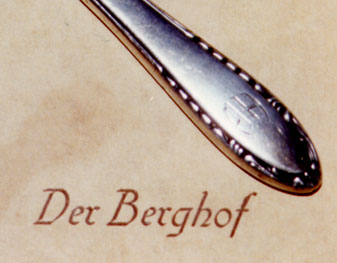 This is a closeup of a dinner knife shank, bearing only Hitler's curved and stylized initials "AH". This style is known to
collectors as the 'Berghof Pattern', because it was evidently used only at Hitler's Bavarian home at Berchtesgaden, and was not found in the places where the other patterns of A.H. silverware were used, such as in his Munich apartment, in the Munich Braunhaus, at the Berlin Chancellery, and aboard his private train.
This is a closeup of a dinner knife shank, bearing only Hitler's curved and stylized initials "AH". This style is known to
collectors as the 'Berghof Pattern', because it was evidently used only at Hitler's Bavarian home at Berchtesgaden, and was not found in the places where the other patterns of A.H. silverware were used, such as in his Munich apartment, in the Munich Braunhaus, at the Berlin Chancellery, and aboard his private train.
Sgt Bill Knight of Service Co., 506th liberated this knife in the Berghof. It was photographed on the cover of a photo card album entitled "Der Berghof", which is filled with color postcard type pictures, giving assorted views of Hitler's mountain home. That album was found in the bottom of the Eagle's Nest elevator shaft, where it had been tossed with scores of other books by the SS, before the area was liberated. Berghof album c/o Carl Beck, H/501.
Compared to this, the items above were small potatoes
 One of the famous looted paintings in Herman Goring's art collection was the
painting 'Christ and the Adultress', said to have been painted by the Dutch master, Vermeer. The painting was discovered
rolled up in a tube, in the effects of Frau Goring's Polish lady in waiting, at the Fischorn castle in Bruck, Austria.
One of the famous looted paintings in Herman Goring's art collection was the
painting 'Christ and the Adultress', said to have been painted by the Dutch master, Vermeer. The painting was discovered
rolled up in a tube, in the effects of Frau Goring's Polish lady in waiting, at the Fischorn castle in Bruck, Austria.
Assuming this was an original Vermeer painting, it was turned over to a Dutch museum. In postwar months, it was determined
that this particular 'Vermeer' never even existed in the first place. It was a forgery, painted in the style of the Dutch
master by a counterfeiter, who duplicated other Vermeer paintings for witnessing authorities, to prove his claim of having
produced 'Christ & the Adultress'.
This is NOT an item in the webmaster's collection!
photo courtesy Nadine W.
Hitler's Giant Window
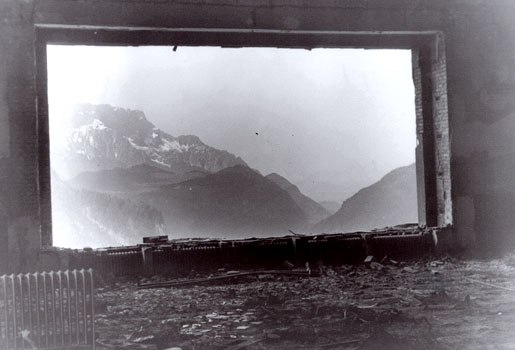 The huge picture window at Hitler's home, 'The Berghof' (literally 'Mountain
House')is not to be confused with the smaller, more square windows at the Eagle's Nest, which was on the next (Kehlstein)
mountain.
The huge picture window at Hitler's home, 'The Berghof' (literally 'Mountain
House')is not to be confused with the smaller, more square windows at the Eagle's Nest, which was on the next (Kehlstein)
mountain.
The Berghof was damaged by allied bombs before the 101st arrived in the area (note rubble on floor), and this
huge window did have a bullet resistant steel door, which could be lowered, to cover the glass, somewhat like a garage door.
Note the row of radiators as well, used to defrost the windows, to ensure a clear view. It is said that on a clear day,
Hitler could see four countries from this window-Germany, Austria, Italy, and Switzerland, a fact which helped him dream
that he owned the world.
According to Fred Bahlau of the 506th, there was a small room to the right of this window with
a single toilet in it, and a smaller window. From there, Hitler could enjoy the view, while moving his bowels.
The Plug from Adolf Hitler's Berghof Bath Tub
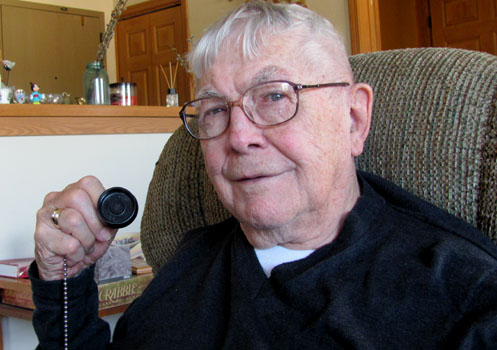 Lt Don Zahn's 2nd platoon of C/506th was given the responsibility of
guarding and securing Hitler's mountain home for the first few days after its liberation. This is the same building which
had the giant picture window shown above. Entering Hitler's former bathroom on the main floor, Lt. Zahn saw a black bakelite
bathtub plug attached to the tub with a bead chain. Zahn removed it as a souvenir. He says: "I thought, maybe Hitler's Ass
was on this..."
Lt Don Zahn's 2nd platoon of C/506th was given the responsibility of
guarding and securing Hitler's mountain home for the first few days after its liberation. This is the same building which
had the giant picture window shown above. Entering Hitler's former bathroom on the main floor, Lt. Zahn saw a black bakelite
bathtub plug attached to the tub with a bead chain. Zahn removed it as a souvenir. He says: "I thought, maybe Hitler's Ass
was on this..."
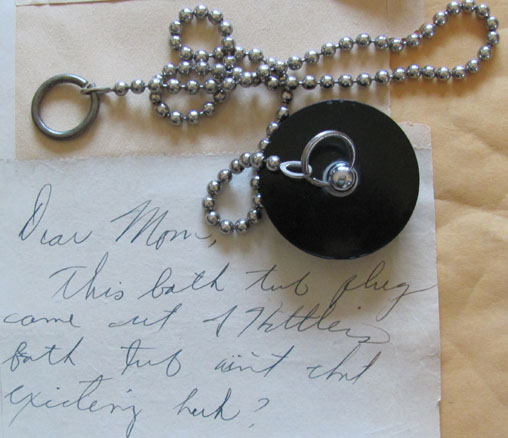 Lt. Zahn mailed the plug to his mother, along with a hand-scribbled note,
describing what it was. Markings on the reverse of the bakelite plug read: FV II 45 41 4B.
Lt. Zahn mailed the plug to his mother, along with a hand-scribbled note,
describing what it was. Markings on the reverse of the bakelite plug read: FV II 45 41 4B.
This item was added to the
webmaster's collection in October, 2011.
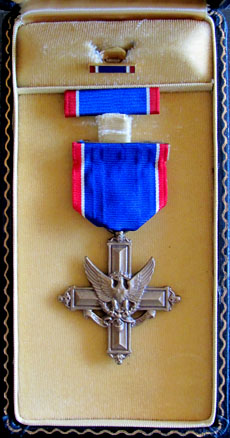 On 9 May, 1945, Lt Zahn was awarded this DSC for actions on D-day at the road
bridge on the Douve river, NE of Carentan. The award ceremony was held in front of the former residence of Field Marshall
Wilhelm Keitel.
On 9 May, 1945, Lt Zahn was awarded this DSC for actions on D-day at the road
bridge on the Douve river, NE of Carentan. The award ceremony was held in front of the former residence of Field Marshall
Wilhelm Keitel.
The edge of Zahn's medal is marked: 1 9 494.
The End-1945
 Symbolic of Allied victory, Captain Jim Nye of the 506th meets a Russian soldier at the border of the new 'Iron Curtain', somewhere in Austria, summer 1945. photo courtesy J. Nye
Symbolic of Allied victory, Captain Jim Nye of the 506th meets a Russian soldier at the border of the new 'Iron Curtain', somewhere in Austria, summer 1945. photo courtesy J. Nye
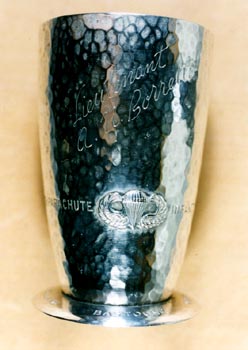
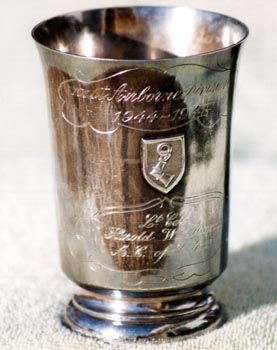 In May, 1945, when troops of the 506th occupied Fegelein's Fischorn Castle at Bruck, Austria (adjacent to the SS Horse Farm), a quantity of silver chalices were liberated. These were marked on the base as having been manufactured at Innsbruck, Austria, and the silver content was .900 fine. An Austrian silversmith near Zell am Zee was commissioned to customize these drinking vessels as follows: One style, having an overall hammered surface, was adopted by the 506th and engraving was done for every officer in the regiment, with each officer's name and rank, the words '506th Parachute Infantry Regt', and a set of facsimilie parachute jump wings (slightly smaller than actual) were attached to the center front. Around the top of the base were engraved the campaigns in which the officer had participated. Lt Tony Borelli's example (l) bears Holland, Bastogne, and Germany, as he did not participate in the Normandy campaign. The pattern at right was given to officers
at the divisional level. At least one other pattern exists,
with a reindeer head and antlers mounted at the front. Those
were given to certain officers of the 502 regiment. Hank Hannah had started the war as S-3 of the 506th PIR, but went to Divisional G-2 before Holland. He was seriously wounded and returned to the states. In 1945, his friends remembered him and mailed him one of each type of chalice shown-the divisional example shown at right is his.
In May, 1945, when troops of the 506th occupied Fegelein's Fischorn Castle at Bruck, Austria (adjacent to the SS Horse Farm), a quantity of silver chalices were liberated. These were marked on the base as having been manufactured at Innsbruck, Austria, and the silver content was .900 fine. An Austrian silversmith near Zell am Zee was commissioned to customize these drinking vessels as follows: One style, having an overall hammered surface, was adopted by the 506th and engraving was done for every officer in the regiment, with each officer's name and rank, the words '506th Parachute Infantry Regt', and a set of facsimilie parachute jump wings (slightly smaller than actual) were attached to the center front. Around the top of the base were engraved the campaigns in which the officer had participated. Lt Tony Borelli's example (l) bears Holland, Bastogne, and Germany, as he did not participate in the Normandy campaign. The pattern at right was given to officers
at the divisional level. At least one other pattern exists,
with a reindeer head and antlers mounted at the front. Those
were given to certain officers of the 502 regiment. Hank Hannah had started the war as S-3 of the 506th PIR, but went to Divisional G-2 before Holland. He was seriously wounded and returned to the states. In 1945, his friends remembered him and mailed him one of each type of chalice shown-the divisional example shown at right is his.
Luftwaffe M35 Combat Helmet
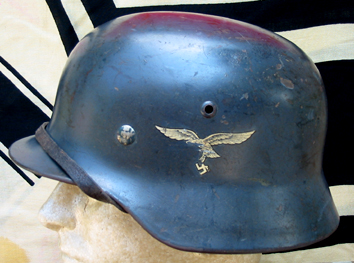 This example was liberated by Sgt William 'Denny'McHugh of Company 'I', 501 PIR. He does not remember when or where he acquired it, either in Normandy or at the end of the war in So. Germany or Austria.
This example was liberated by Sgt William 'Denny'McHugh of Company 'I', 501 PIR. He does not remember when or where he acquired it, either in Normandy or at the end of the war in So. Germany or Austria.
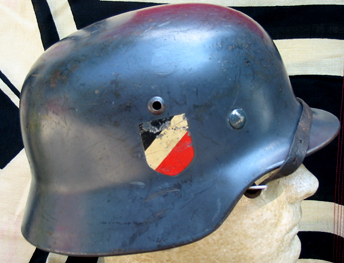 At any rate, the national colors decal remains on the right side, a relative rarity, since orders were issued to scrape those off around 1942. Also after 1940 those decals as well as party decals on political helmets ceased to be applied to newly-issued helmets. This national colors decal looks as if the owner started to scrape it off, then decided not to...an oft-seen type of damage.
At any rate, the national colors decal remains on the right side, a relative rarity, since orders were issued to scrape those off around 1942. Also after 1940 those decals as well as party decals on political helmets ceased to be applied to newly-issued helmets. This national colors decal looks as if the owner started to scrape it off, then decided not to...an oft-seen type of damage.
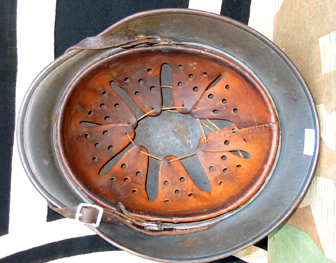 The typical Nazi era liner bears a small name written in ink on the leather, whereas owner's names were often painted in large format inside the back rim of these helmets.
The typical Nazi era liner bears a small name written in ink on the leather, whereas owner's names were often painted in large format inside the back rim of these helmets.
Denny McHugh's Infantry Assault Badge
 Denny, like many other GIs when clowning around, placed German combat decorations on his own class 'A' jacket and posed for the camera. I've had the signed photo for many years and in 2006, I was able to purchase the same German Infantry Assault Badge depicted in the photo from Mr McHugh. The badge itself is not extraordinary, having a missing catch and no maker's hallmark. Still it is nice to have the exact item depicted in the 1945 photo.
Denny, like many other GIs when clowning around, placed German combat decorations on his own class 'A' jacket and posed for the camera. I've had the signed photo for many years and in 2006, I was able to purchase the same German Infantry Assault Badge depicted in the photo from Mr McHugh. The badge itself is not extraordinary, having a missing catch and no maker's hallmark. Still it is nice to have the exact item depicted in the 1945 photo.
German Artillery Sgt's M43 Style Tunic
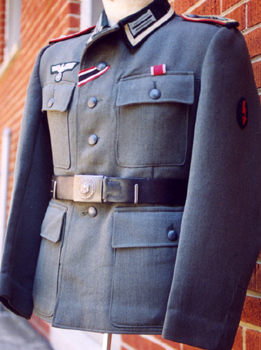 Lt Albert Hassenzahl liberated this custom made, M43 pattern NCO's tunic in a house in Southern Germany in spring, 1945. The tunic was custom-tailored, not for combat, but for walking-out. It is made of a higher quality material (gabardine) and also has an early style bottle green collar added. The pleatless pockets with straight flaps are of the M43 late-war style. The red 'signal blitz' on the left arm indicates the original owner was a communications sgt in an artillery regiment or battalion. The epaulettes are slip-on style and numbered '27', while the breast eagle is also custom-made.
Lt Albert Hassenzahl liberated this custom made, M43 pattern NCO's tunic in a house in Southern Germany in spring, 1945. The tunic was custom-tailored, not for combat, but for walking-out. It is made of a higher quality material (gabardine) and also has an early style bottle green collar added. The pleatless pockets with straight flaps are of the M43 late-war style. The red 'signal blitz' on the left arm indicates the original owner was a communications sgt in an artillery regiment or battalion. The epaulettes are slip-on style and numbered '27', while the breast eagle is also custom-made.
The tunic bears medal ribbons for the pre-war Austrian Anschluss and the War Service Cross 2nd Class.




































